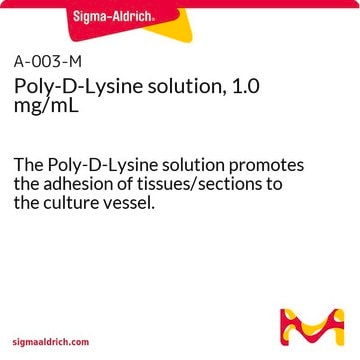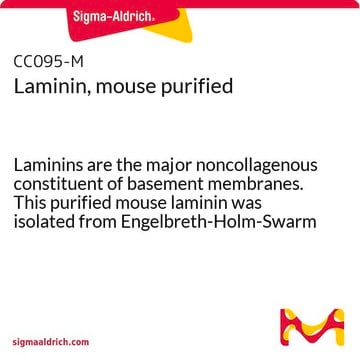A-004-M
Poly-ʟ-Ornithine
synthetic, liquid, 0.1 mg/mL, suitable for cell culture
Synonyme(s) :
Poly-L-Ornithine Solution (0.01%), A-004-M, Sigma-Aldrich
About This Item
Produits recommandés
product name
Poly-L-Ornithine Solution (0.01%),
Taille de l'aiguille
2.0 mm
Niveau de qualité
Stérilité
sterile
Forme
liquid
Poids mol.
Mw 78000 Da
Fabricant/nom de marque
NovaSeptum®
Concentration
0.01 % (w/v)
0.1 mg/mL
Technique(s)
cell attachment: suitable
cell culture | mammalian: suitable
Description générale
Research Sub Category: Adhesion (CAMs)
Application
- glass-bottom plates for cell plating in a research study investigating the localization of cMET in MDA-MB-468 cells using confocal microscopy
- culture dishes for adult human neural stem cells (ahNSCs) primary culture
- 6-well plates for induced pluripotent stem cells (iPSCs) culture and neuronal differentiation
Qualité
Forme physique
Notes préparatoires
2. Dilute Poly-L-Ornithine solution to the desired concentration in sterile water.
3. Fully coat the cell culture surface with diluted Poly-L-Ornithine solution. Use 5 mL volume for 6-cm plates and 10 mL volume for 10-cm plates and T75 flasks.
4. Allow the cell culture vessel to sit at room temperature overnight.
5. Aspirate the Poly-L-Ornithine solution the following day and rinse the vessel with sterile water followed by coating with desired ECM protein. Optimal coating concentrations must be determined by the end user. Typical coating concentrations range from 10ug/ml to 100ug/ml based on cell type and application.
Stockage et stabilité
Informations légales
Clause de non-responsabilité
Code de la classe de stockage
12 - Non Combustible Liquids
Classe de danger pour l'eau (WGK)
WGK 1
Point d'éclair (°F)
Not applicable
Point d'éclair (°C)
Not applicable
Certificats d'analyse (COA)
Recherchez un Certificats d'analyse (COA) en saisissant le numéro de lot du produit. Les numéros de lot figurent sur l'étiquette du produit après les mots "Lot" ou "Batch".
Déjà en possession de ce produit ?
Retrouvez la documentation relative aux produits que vous avez récemment achetés dans la Bibliothèque de documents.
Les clients ont également consulté
Notre équipe de scientifiques dispose d'une expérience dans tous les secteurs de la recherche, notamment en sciences de la vie, science des matériaux, synthèse chimique, chromatographie, analyse et dans de nombreux autres domaines..
Contacter notre Service technique












